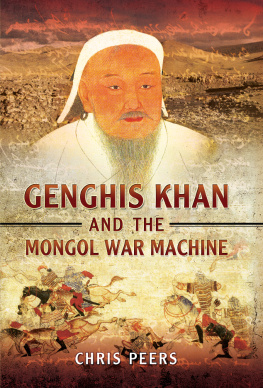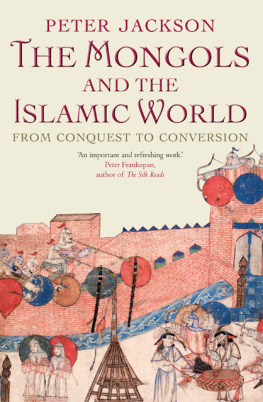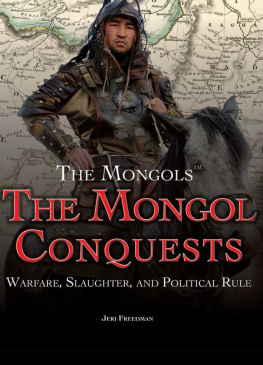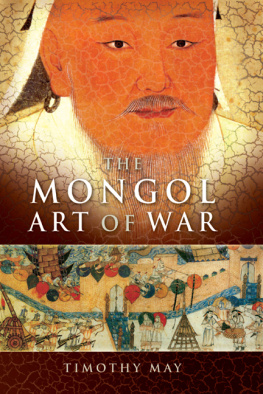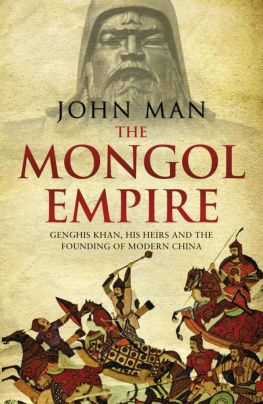ACKNOWLEDGEMENTS
Editing a book this large takes a great deal of work and collaboration, and the authors are grateful to all of the contributors who took the time to submit chapters. Their work and support, despite the stress and restrictions imposed by the Coronavirus pandemic, is greatly appreciated.
We would also like to thank Don Larson and company at Mapping Specialists for their outstanding work on the maps that appear in this volume.
Timothy May thanks Scott Jacobs for his generous support for Timothys research and the University of North Georgia College of Arts & Letters for its assistance in producing The Mongol World, as well as Eugene Van Sickle for his good humor as he had to put up with nearly daily whinging on the topic of edited volumes while on patrol. He also thanks Michael Hope for agreeing to sign on as co-editor, as this volume would not have been possible without his stalwart effort.
Michael Hope would like to thank Bradford Bow for his friendship, advice, and support and Timothy May for making the last three years such an enjoyable and rewarding collaboration.
The authors thank the good folks at Routledge (Laura Pilsworth, Morwenna Scott, and Izzy Voice) for approaching them about this project as well as their endless patience and encouragement throughout the process. Izzy deserves special praise for fielding last-minute questions, changing deadlines due to pandemic-induced delays, and of course shepherding the authors through production.
We would both like to thank our spouses and children for their patience and not rolling their eyes too frequently when Mongols are mentioned. And finally, this work could never have been completed without the stern criticism from E. H. Doom and C. Kitty, both of whom were supervised by M. Leia.
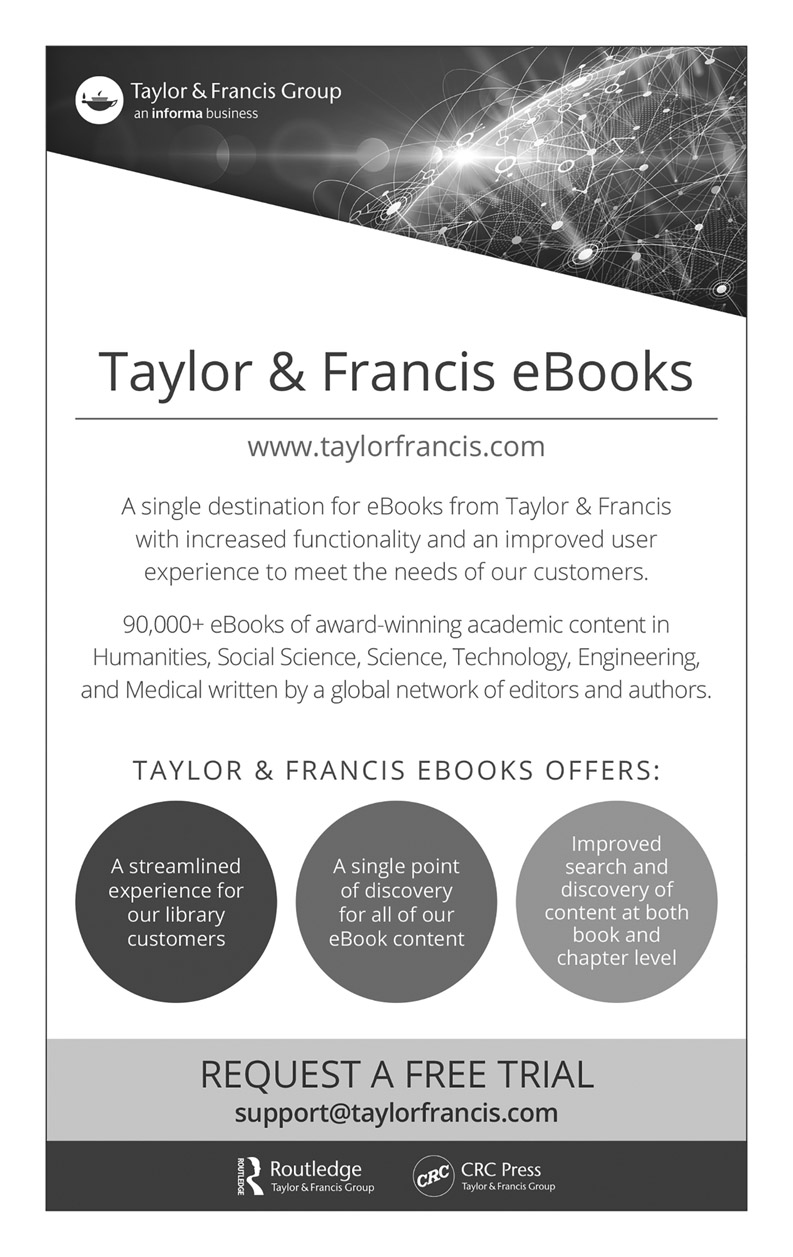
CHAPTER ONE MONGOLIA BEFORE CHINGGIS KHAN
Isenbike Togan
DOI: 10.4324/9781315165172-5
INTRODUCTION
Mongolia is part of Inner Asia but also of Asia in general, and in that sense takes part in the patterns of Asian history with its periods of universalism and localism following one another in alternation up to the emergence of the Mongolian Empire in the 13th14th centuries. In the periods of universalism empires coexisted across Asia: the first period saw the Qin-Han in China, the Xiongnu in the steppe (ca. 200BCE-200CE) and the Roman Empire in the west (until 395CE). In the second phase of universalism we see the Tang, the early Trk, the Uyghurs, (ca 550850) Byzantium and the Islamic empires. These were all multiethnic, multicultural political entities established along trade routes, yet they had differing trade policies.
The nomadic empires in the north ruled over a vast area and favored redistribution of surplus in a power-sharing arrangement. Moreover, they promoted free trade, the profits of which were collected and redistributed locally. Sedentary states or empires in turn were interested in accumulation of surplus at a center and preferred to control trade with the outside world by making use of their bureaucracy. Another way in which the eastern and western parts of Asia differed was in terms of their outlook towards religions. During the first millennium, in the eastern parts of Asia, different religions coexisted under the umbrella of the imperial state. Western Asia was the cradle of religions such as Judaism, Christianity and Islam, with monotheism clearly dominant.
In the periods of localism, there was not such a difference between eastern and western Asia. It was instead a world of many political actors of diverse denominations. On the whole, we see the emergence of lesser groups, both sedentary and nomadic, while leadership was mostly in the hands of more or less one ethnic group. These groups were open to trade, as well as to the cultural and spiritual influences brought by these traders. Periods of localism were politically unstable but intellectually exciting times that were also conducive to the emergence of new spiritual movements and the creation of new aesthetic patterns.
Localist periods (220550 and 9501206) are marked by principalities, sultanates, khanates, chiefdoms and even smaller groups. They occur after the collapse of empires. Furthermore, while small polities emerged in the sedentary regions, clans, tribes, tribe segments and retainer groups existed in the steppe. It was within the shadow of conflicts among the steppe people that they made incursions into the sedentary regions along the trade routes, contributing to the fragmentation of the political structures. They did not venture into conquests. It was among pastoral nomadic people of the second localist period that Chinggis Khan became a leader and rose to eminence.
METHODOLOGY
Starting from the second half of the 18th century, western ethnographic literature described the nomadic population of Inner Asia as tribes. In these descriptions, tribe is a category for people who have remained primitive, underdeveloped since ancient times. In this view unchangingness was prevalent both diachronically (time) and synchronically (space). If differences were observed, they seemed to be regional and were reflected in tangible heritage, that is in the attire, utensils or customs of the people concerned. The travelers as well as the scholars interest was in the simple, pure and exotic.
Historians of the 19th and 20th centuries were actually not familiar with the notion of tribe in terms of their own socialization. The historical people concerned, on the other hand, often have many different terms for similar groupings. Sometimes these people do not even bother to define a term, as they are themselves familiar with it. For instance the present-day Kazakhs use the term ru for all categories under a zhuz, one of the three main divisions among the Kazakhs. A tribe as well as its subdivisions can be called ru. It is for us outsiders to figure out what they mean. What is clearly apparent for an insider needs to be neatly categorized by the outsider so that it is understandable. Our need to categorize leads to a concern with terminology. Additionally, we tend to look at categories and terminologies as static and unchanging aspects of human organization. We take notions such as tribe as unchanging entities. However, the actors in historical societies use different terms for those concepts we understand to be one static unit. Through history, Inner Asian nomads lived and experienced these notions in different forms; they did not feel the need to bring all these different forms under one neat umbrella. Apparently, it was felt that one specific term would blur differences and nuances. For us, on the other hand, such terms represent useful categories. Scholars have scrutinized whether tribes were kinship groups. Moreover, the question of what kind of terminology was used by the indigenous people such as the Mongols has been another concern.
In the present study, instead of using todays terminology as an analytic category, the usage and the terminology of the sources themselves have been employed. This kind of approach will be seen in the case of Chinese as well as Persian sources. The analytic tool in the present study is the socio-political structure of these pastoral nomads. This structure has been defined as kin and non-kin groups and has been derived from historical texts. As a result, what historical texts tell us in their own terms represents the warp and weft of their own times. They make us aware of notions such as common descent, seniority by life cycle, stratification and hierarchy. The kin groups emphasize common descent, while the non-kin groups appear as stratified and hierarchical. Some seem to be semi-stratified. The emerging picture is not a one-way anarchy as Vladimirtsov described it.


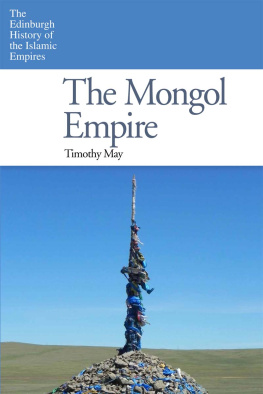
![Timothy May - The Mongol Empire [2 Volumes]: A Historical Encyclopedia](/uploads/posts/book/143064/thumbs/timothy-may-the-mongol-empire-2-volumes-a.jpg)



